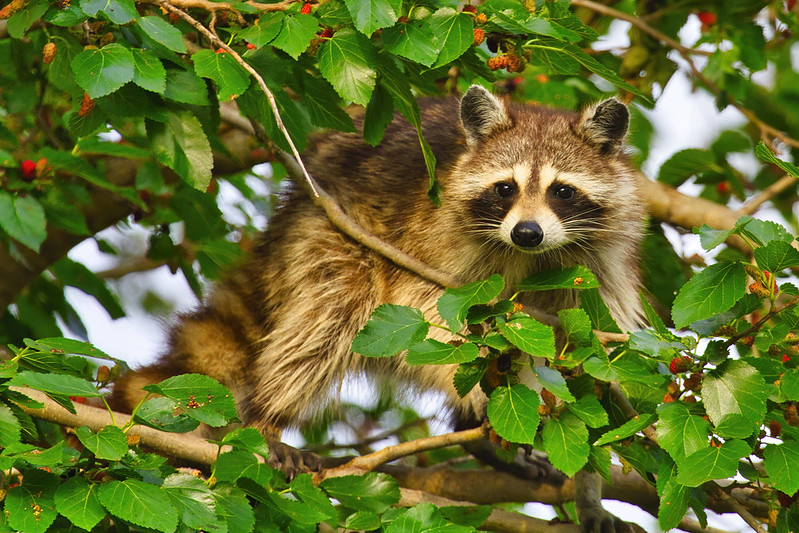Wildlife photography is always full of unexpected moments, and my visits to Sequoyah National Wildlife Refuge in Oklahoma are no exception. One of my favorite locations at the refuge is a Mulberry Tree that reliably attracts a variety of birds during mulberry season. The ripe berries combined with soft early morning light make it a perfect spot for capturing detailed bird photos.
On one particular visit, however, the tree offered a surprise subject,a raccoon. Although I wasn’t able to get a good photo that day, I had better luck on May 22, 2014, when I photographed a raccoon in a different Mulberry Tree.

Raccoons and Mulberries: A Natural Match
Raccoons are incredibly adaptable omnivores. Their diet ranges from berries and nuts to insects, fish, and small mammals. With their natural curiosity and nimble front paws, they’re naturally drawn to fruiting trees like the mulberry,especially during the early morning or late evening when they’re most active.
One fascinating behavior raccoons display is “dousing,” or dunking their food in water before eating. While the exact reason is still debated, it may help soften the food or simulate natural foraging behavior.
The raccoon’s black facial mask isn’t just for looks. It may help reduce glare and improve night vision. Their ringed tails and coarse fur make them easy to identify, even when partially hidden among the leaves.
If you’re interested in other animals enjoying mulberries, check out this Cedar Waxwing feeding on a mulberry. It’s another great example of the wildlife drawn to these trees.
Wildlife Photography at Sequoyah National Wildlife Refuge
Although I primarily visit this refuge to photograph birds, surprises like this raccoon keep me alert and inspired. Every trip into the field is a chance for something new. Spotting the raccoon moving among the mulberry branches was a highlight I hadn’t anticipated, and it’s moments like these that make each outing special.
Camera Settings for This Photo
- Camera: Canon EOS 7D
- Lens: Canon EF 100-400mm f/4.5-5.6L IS USM
- Support: Bean bag on truck window
- Aperture: f/5.6
- ISO: 400
- Shutter Speed: 1/400 sec
- Focal Length: 390 mm
FAQ
What do raccoons eat in the wild?
Raccoons eat a wide variety of foods, including fruits, nuts, insects, fish, and small mammals. They are also known to scavenge from bird feeders and garbage cans.
When are raccoons most active?
Raccoons are mainly nocturnal but are often active during dawn and dusk, particularly when food sources like mulberries are available.
Why do raccoons dip their food in water?
This behavior, called “dousing,” may help soften their food or reflect natural foraging instincts, although its exact purpose is still uncertain.
How do raccoons use their front paws?
Raccoons have sensitive and dexterous front paws that allow them to grasp and manipulate objects and food with surprising skill.
Where is the best place to see wildlife at Sequoyah National Wildlife Refuge?
During mulberry season, the Mulberry Trees are a hotspot for bird activity,and occasional surprise visits from raccoons.
